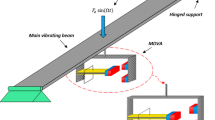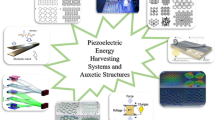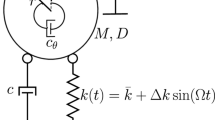Abstract
Introduction
This research paper investigates the dynamics and control of a non-ideal magnetic levitation (Maglev) system, with its potential for energy harvesting. The system in view consists of a center body suspended by magnetic forces on the top and bottom with a shaker at the base.
Purpose
The study aims to explore the behavior of the Maglev system under varying conditions and its potential to enhance energy harvesting performance.
Method
Approximate solution of the nonlinear Maglev system oscillation is obtained by implementing a perturbation technique referred to as the method of multiple scales. A fourth-order numerical method is applied to obtain the time response and the outcomes are visually presented through Poincare maps, phase plane, bifurcation analysis and parametric variations.
Result
This research considered capacitance adjustment to induce internal resonance, yielding pronounced periodic oscillations with varying excitation voltage. Detailed analyses demonstrate periodic motion for the electric shaker's charge and for the middle block displacement, affirming analytical predictions.
Conclusion
The study emphasizes internal resonance potential for enhancing average power output and highlights a direct proportional relationship between the middle block and shaker’s velocity at low frequencies. Under internal resonance, average harvested power increases by approximately compared to no internal resonance case, showcasing its effectiveness in enhancing energy harvesting performance.














Similar content being viewed by others
Availability of Data and Material
The datasets generated during and/or analyzed during the current study are available from the corresponding author on reasonable request.
References
Zhang X, Li G, Su S (2024) Numerical and experimental performance study of magnetic levitation energy harvester with magnetic liquid for low-power-device’s energy storage. J Energy Storage. https://doi.org/10.1016/j.est.2023.109584
Zhang J, Shao H, Zhang L, Liu D, Aw KC, Su Y (2024) Frequency tunable electromagnetic vibration energy harvester based on diamagnetic levitation. Appl Phys A Mater Sci Process. https://doi.org/10.1007/s00339-023-07264-y
Fang J, Fan B, Li C, Lv M (2023) A piezoelectric-electromagnetic hybrid energy harvester inspired by flapping motion of the Diptera insect. Smart Mater Struct. https://doi.org/10.1088/1361-665X/acf53c
Zhou W, Du D, Cui Q, Yang Z, Lu C, He Q (2023) Dynamic analysis of novel bionic piezoelectric vibration energy harvester for power transformer. Energy. https://doi.org/10.1016/j.energy.2023.130135
Dal Bo L, Gardonio P (2018) Energy harvesting with electromagnetic and piezoelectric seismic transducers: Unified theory and experimental validation. J Sound Vib 433:385–424. https://doi.org/10.1016/j.jsv.2018.06.034
Harb A (2011) Energy harvesting: State-of-the-art. Renew Energy 36:2641–2654. https://doi.org/10.1016/j.renene.2010.06.014
Balko P, Rosinova D (2017) Modeling of magnetic levitation system. In: Proceedings of the 2017 21st International Conference on process control, PC 2017. pp. 252–257. Institute of Electrical and Electronics Engineers Inc.
Kecik K, Mitura A, Lenci S, Warminski J (2017) Energy harvesting from a magnetic levitation system. Int J Non Linear Mech 94:200–206. https://doi.org/10.1016/j.ijnonlinmec.2017.03.021
Imbaquingo C, Bahl C, Insinga AR, Bjørk R (2022) A two-dimensional electromagnetic vibration energy harvester with variable stiffness. Appl Energy. https://doi.org/10.1016/j.apenergy.2022.119650
Roundy S, Wright PK, Rabaey J (2003) A study of low level vibrations as a power source for wireless sensor nodes. Comput Commun 26(11):1131–1144
Mann BP, Sims ND (2009) Energy harvesting from the nonlinear oscillations of magnetic levitation. J Sound Vib 319:515–530. https://doi.org/10.1016/j.jsv.2008.06.011
Engel E, Wei J, Lee CL (2015) Enhanced vibration energy harvesting using nonlinear oscillations. In: Energy harvesting and storage: materials, devices, and applications VI. p. 94930Q. SPIE (2015)
Roundy S, Wright PK, Rabaey JM (2004) Energy scavenging for wireless sensor networks. Springer US
Rocha RT, Balthazar JM, Tusset AM, Piccirillo V, Felix JLP (2016) Using saturation phenomenon to improve energy harvesting in a portal frame platform with passive control by a pendulum. In: Awrejcewicz J (ed) Dynamical systems: theoretical and experimental analysis. Springer Proceedings in Mathematics & Statistics, vol 182. Springer, Cham. https://doi.org/10.1007/978-3-319-42408-8_25
Nammari A, Doughty S, Savage D, Weiss L, Jaganathan A, Bardaweel H (2016) Broadband magnetic levitation-based nonlinear energy harvester. In: Energy harvesting and storage: materials, devices, and applications VII. p 98650L, SPIE
Yadav M, Mehta N, Gupta A, Chaudhary A, Mahindru DV (2013) Review of magnetic levitation (maglev): a technology to propel vehicles with magnets. Global J Res Eng Mech Mech 13(7):32–33
Andò B, Baglio S, Bulsara AR, Marletta V, Pistorio A (2017) Investigation of a nonlinear energy harvester. IEEE Trans Instrum Meas 66:1067–1075. https://doi.org/10.1109/TIM.2017.2663178
Kecik K, Kowalczuk M (2021) Effect of nonlinear electromechanical coupling in magnetic levitation energy harvester. Energies (Basel). https://doi.org/10.3390/en14092715
Yamapi R (2006) Dynamics of an electromechanical damping device with magnetic coupling. Commun Nonlinear Sci Numer Simul 11:907–921. https://doi.org/10.1016/j.cnsns.2005.02.001
Stanton SC, McGehee CC, Mann BP (2009) Reversible hysteresis for broadband magnetopiezoelastic energy harvesting. Appl Phys Lett. https://doi.org/10.1063/1.3253710
Stanton SC, McGehee CC, Mann BP (2010) Nonlinear dynamics for broadband energy harvesting: Investigation of a bistable piezoelectric inertial generator. Phys D 239:640–653. https://doi.org/10.1016/j.physd.2010.01.019
Karami MA, Inman DJ (2010) Nonlinear hybrid energy harvesting utilizing a piezo-magneto-elastic spring. In: Active and passive smart structures and integrated systems 2010, vol. 7643, pp. 245–255, SPIE (2010)
Kamel M, Kandil A, El-Ganaini WA, Eissa M (2014) Active vibration control of a nonlinear magnetic levitation system via Nonlinear Saturation Controller (NSC). Nonlinear Dyn 77:605–619. https://doi.org/10.1007/s11071-014-1323-3
Yang W, Towfighian S (2017) Internal resonance and low frequency vibration energy harvesting. Smart Mater Struct. https://doi.org/10.1088/1361-665X/aa791d
Eissa M, Kandil A, El-Ganaini WA, Kamel M (2015) Analysis of a nonlinear magnetic levitation system vibrations controlled by a time-delayed proportional-derivative controller. Nonlinear Dyn 79:1217–1233. https://doi.org/10.1007/s11071-014-1738-x
Bolla MR, Balthazar JM, Felix JLP et al (2007) On an approximate analytical solution to a nonlinear vibrating problem, excited by a nonideal motor. Nonlinear Dyn 50:841–847. https://doi.org/10.1007/s11071-007-9232-3
Cao DX, Leadenham S, Erturk A (2015) Internal resonance for nonlinear vibration energy harvesting. Eur Phys J Spec Top 224:2867–2880. https://doi.org/10.1140/epjst/e2015-02594-4
Wang Z, Wang W, Zhang Q, Gu F, Ball D (2019) Analysis of nonlinear vibration energy harvesters using a complex dynamic frequency method. IOS Press
Wang Z, Feng H, Ding H, Chen L (2019) Parametric influence on energy harvesting of magnetic levitation using harmonic balance method. J Vib Eng Technol 7:543–549. https://doi.org/10.1007/s42417-019-00148-7
Zhang S, Zhang Y, Sun Z, Duan X (2020) Dynamics of a nonlinear energy harvesting system in time-delayed feedback control under stochastic excitations. Complexity. https://doi.org/10.1155/2020/8460350
El-Ganaini WA, Kandil A, Eissa M, Kamel M (2016) Effects of delayed time active controller on the vibration of a nonlinear magnetic levitation system to multi excitations. JVC/J Vib Control 22:1257–1275. https://doi.org/10.1177/1077546314536753
Balthazar JM, Mook DT, Weber HI et al (2003) An overview on non-ideal vibrations. Meccanica 38:613–621. https://doi.org/10.1023/A:1025877308510
Iliuk I, Balthazar JM, Tusset AM, Piqueira JRC, Rodrigues de Pontes B, Felix JLP, Bueno Á (2013) A non-ideal portal frame energy harvester controlled using a pendulum. Europ Phys J Spec Top 222:1575–1586. https://doi.org/10.1140/epjst/e2013-01946-4
Stephen NG (2006) On energy harvesting from ambient vibration. J Sound Vib 293:409–425. https://doi.org/10.1016/j.jsv.2005.10.003
Iliuk I, Balthazar JM, Tusset AM, Felix JLP, de Pontes BR (2013) On non-ideal and chaotic energy harvester behavior. Differ Equ Dyn Syst 21:93–104. https://doi.org/10.1007/s12591-012-0127-5
Iliuk I, Balthazar JM, Tusset AM, Felix JLP, de Pontes BR (2012) Nonlinear dynamics and control strategies: On a energy harvester vibrating system with a linear form to non-ideal motor torquet. MATEC Web of Conferences 1:08003. https://doi.org/10.1051/matecconf/20120108003
Shan X, Xu Z, Xie T (2013) New electromechanical coupling model and optimization of an electromagnetic energy harvester. Ferroelectrics 450(1):66–73. https://doi.org/10.1080/00150193.2013.838491
Arbex HC, Balthazar JM, de Pontes Junior BR, da Fonseca Brasil RMLR, Felix JLP, Tusset AM, Bueno ÁM (2015) On nonlinear dynamics behavior and control of a new model of a magnetically levitated vibrating system, excited by an unbalanced DC motor of limited power supply. J Brazil Soci Mech Sci Eng 37:1139–1150. https://doi.org/10.1007/s40430-014-0233-0
Rocha RT, Balthazar JM, Tusset AM, de Souza SLT, Janzen FC, Arbex HC (2019) On a non-ideal magnetic levitation system: nonlinear dynamical behavior and energy harvesting analyses. Nonlinear Dyn 95:3423–3438. https://doi.org/10.1007/s11071-019-04765-5
Jazar RN (2021) Perturbation methods in science and engineering. Springer
Nayfeh, Ali H, Mook DT (2008) Nonlinear oscillations. Wiley
Acknowledgements
Abraham C. Francis acknowledges JICA through TICAD7 scholarship program.
Funding
Open access funding provided by The Science, Technology & Innovation Funding Authority (STDF) in cooperation with The Egyptian Knowledge Bank (EKB).
Author information
Authors and Affiliations
Corresponding author
Ethics declarations
Conflict of Interest
The authors declare that they have no potential competing interests.
Additional information
Publisher's Note
Springer Nature remains neutral with regard to jurisdictional claims in published maps and institutional affiliations.
Appendices
Appendix A
The components of the square matrix for the stability criteria of Eqs. (25a, 25b) and (26a, 26b) are given below.
Appendix B
The square matrix components for the stability criteria of Eqs. (40a, 40b) and (41a, 41b) are given below.
Appendix C
This mechanical analysis explains the energy dynamics within the energy harvesting device. It comprises of the kinetic and potential energy components, energy dissipation mechanisms, Lagrangian function formulation, and Euler–Lagrange equations. This mathematical analysis lays the groundwork for designing an effective energy harvesting strategy. The kinetic energy can be expressed as follows:
The potential energy can also be written as:
The energy dissipation is written as:
The Lagrangian of this system can be written as
The Euler–Lagrange equations \(\frac{d}{dt}\left(\frac{\partial L}{\partial {\dot{x}}_{i}}\right)-\frac{\partial L}{\partial {x}_{i}}+\frac{\partial D}{\partial {\dot{x}}_{i}}={F}_{ex}\) (for \(i=\mathrm{1,2}\)) such that \({x}_{1}=x\) and \({x}_{2}=q\) are modified by including additional terms that capture the energy dissipation and the energy harvesting mechanism. This can lead us to Eqs. (1) and (2).
Rights and permissions
Springer Nature or its licensor (e.g. a society or other partner) holds exclusive rights to this article under a publishing agreement with the author(s) or other rightsholder(s); author self-archiving of the accepted manuscript version of this article is solely governed by the terms of such publishing agreement and applicable law.
About this article
Cite this article
Francis, A.C., Zahra, W.K., Elsaid, A. et al. Improvement of the Non-periodic Energy Harvesting Behavior of a Non-ideal Magnetic Levitation System Utilizing Internal Resonance. J. Vib. Eng. Technol. (2024). https://doi.org/10.1007/s42417-024-01364-6
Received:
Revised:
Accepted:
Published:
DOI: https://doi.org/10.1007/s42417-024-01364-6




